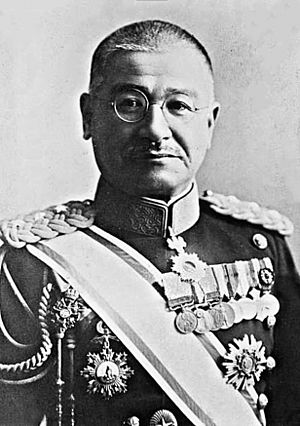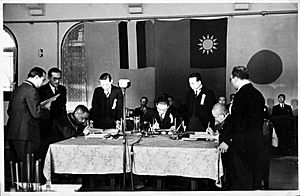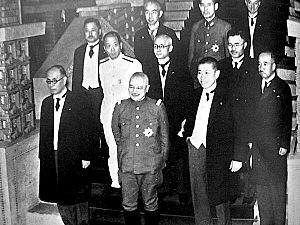Nobuyuki Abe facts for kids
Quick facts for kids
Nobuyuki Abe
|
|
|---|---|
|
阿部 信行
|
|
 |
|
| Prime Minister of Japan | |
| In office 30 August 1939 – 16 January 1940 |
|
| Monarch | Shōwa |
| Preceded by | Kiichirō Hiranuma |
| Succeeded by | Mitsumasa Yonai |
| Minister of Foreign Affairs Empire of Japan |
|
| In office January 1939 – August 1939 |
|
| Monarch | Shōwa |
| Preceded by | Hachirō Arita |
| Succeeded by | Kichisaburō Nomura |
| Governor General of Korea Empire of Japan |
|
| In office 22 July 1944 – 12 September 1945 |
|
| Monarch | Shōwa |
| Preceded by | Kuniaki Koiso |
| Succeeded by | Position abolished |
| Personal details | |
| Born | 24 November 1875 Kanazawa, Japan |
| Died | 7 September 1953 (aged 77) Tokyo, Japan |
| Political party | Taisei Yokusankai (1940–1945) |
| Other political affiliations |
Independent (Before 1940) |
| Alma mater | Imperial Japanese Army Academy Army War College |
| Profession | General |
General Nobuyuki Abe (阿部 信行, Abe Nobuyuki, 24 November 1875 – 7 September 1953) was a high-ranking officer, or "general," in the Imperial Japanese Army. He also served as the Governor-General of Korea and as the Prime Minister of Japan.
Contents
Early Life and Military Career
Nobuyuki Abe was born on November 24, 1875, in Kanazawa, Japan. His father, Abe Nobumitsu, was a former samurai, a type of warrior from old Japan. Nobuyuki Abe's brother-in-law was Shigeyoshi Inoue, an admiral in the Japanese Navy.
Abe went to Tokyo No.1 Middle School and No.4 High School. While still a student, he chose to join the military during the First Sino-Japanese War.
After the war, Abe graduated from the Imperial Japanese Army Academy in November 1897. He became a second lieutenant in June 1898. He was promoted to lieutenant in 1900 and studied at the Army Artillery School. In 1903, he became a captain and joined the Army War College, finishing his studies in 1907.
Abe became a major in 1908 and taught at the Army War College. In 1910, he went to Germany to work as a military attaché. This meant he was a military expert working at the Japanese embassy. He also worked at the embassy in Vienna in 1913.
He was promoted to lieutenant colonel in 1915 and to colonel in 1918. From 1918 to 1921, he led the 3rd Field Artillery Regiment. His regiment went to Siberia in 1918 during Japan's Siberian Intervention, but they did not fight.
In 1921, he became secretary of the Army War College. He was promoted to major general in 1922. After a big earthquake in 1923, he helped manage the Kanto region under martial law. Martial law is when the military takes control of an area during an emergency.
Abe continued to rise in the military. He became director of military service affairs in 1926. In 1927, he was promoted to lieutenant general. He also served as the Vice Minister of the Army. From 1930, he commanded the 4th Infantry Division.
In 1932, Abe was put in charge of the Japanese Taiwan Army. He became a full general in 1933. After serving on the Supreme War Council, he retired from active duty in 1936.
Becoming Prime Minister
Nobuyuki Abe was not the first person people thought of to be Prime Minister. After the previous government fell, other leaders were considered. However, the military and powerful groups wanted a general. The top advisor to the Emperor, called a genrō, wasn't keen on the main candidates.
Another general, Ugaki Kazushige, was a strong choice but became ill. So, General Abe was chosen as a compromise. He was seen as a good choice because he didn't belong to the main political groups within the Army. He was also considered a moderate by the Japanese Navy. However, some senior Army officers didn't like him because he had never fought in a battle.
Abe became Prime Minister on August 30, 1939. He also served as the Foreign Minister at the same time.
During his four months as Prime Minister, Abe wanted to end the Second Sino-Japanese War quickly. He also wanted Japan to stay neutral in the growing war in Europe. He was against some parts of the Army that wanted Japan to become allies with Nazi Germany and Fascist Italy. Because he didn't have strong support from the military or political parties, Abe was replaced by Mitsumasa Yonai in January 1940.
Later Career and Public Service

Three months after he stopped being Prime Minister, Abe was sent to China. He went as a special envoy, which means a special representative. His job was to advise the Japanese-supported government of Wang Jingwei in Nanjing. He also negotiated a treaty to make sure Japan had economic and military rights in northern China. Abe stayed as the Japanese ambassador in Nanjing until December 1940.
After returning to Japan, Abe joined the House of Peers in 1942. This was a part of the Japanese parliament. He also took on a mostly ceremonial role as president of the Imperial Rule Assistance Political Association. In 1944, he was appointed the 10th and last Governor-General of Korea. He served in this role until 1945.
After World War II, Abe was removed from public office by the American occupation government. He was arrested, but he was not found guilty of any serious crimes and was released soon after.
His second son was Nobuhiro Abe.
Honours
- Grand Cordon of the Order of the Sacred Treasure (November 1930)
- Grand Cordon of the Order of the Rising Sun (April 1934)
See also
 In Spanish: Nobuyuki Abe para niños
In Spanish: Nobuyuki Abe para niños


